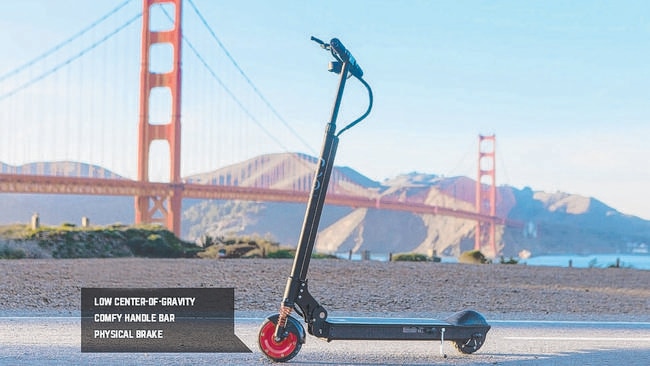Lapping pedestrians on the last mile
THE last mile transport craze is gaining momentum, if this year’s Consumer Electronics Show is any guide.

THE last mile transport craze is gaining momentum, if this year’s Consumer Electronics Show is any guide. That’s the use of small motorised objects to commute short distances, such as from inner urban precincts to the city centre.
These can be small, foldable motorised scooters that you take on the train, mini motorbikes, motorised skateboards and even shoe attachments that help you walk faster. All were on show at this month’s CES in Las Vegas.
There’s nothing new about these. The Segway has been with us since around 2000. And who could forget the hoverboard from the 1985 sci-fi film Back to the Future?
In Europe, gliding at around 10km/h out and about is becoming common, although mostly you’ll find these devices on bike paths and footpaths rather than roadways. In some countries you can use them unregulated, others require you install a tail-light and numberplate, and have age restrictions.
Australia has some of the strictest laws prohibiting their use: they’re too vulnerable for a road and a menace to pedestrians on footpaths.
But you might get away with motor-skateboarding your way around an exhibition or Hovertraxing your way through a large office or a warehouse. Australia’s ageing population too might take to them — provided people retain their sense of balance before darting about.
Manufacturers can pack them with cheap sensors to aid balancing and smooth out movement. That makes them even more attractive.
At CES I was able to ride the EcoReco foldable scooter, with a top speed of 32km/h and 32km range, through a crowded exhibition hall at CES, thankfully without becoming news by running into other participants.
I even tried Solowheel’s Hovertrax, a motorised two-wheel self-balancing platform with three-axis gyrosensors and accelerometers that performs electronic pirouettes — if you are skilful enough. I was happy to just travel in a straight line. The Hovertrax can do 8km/h. The very similar IO Hawk also made an appearance at the show.
As did the motorised Zboard 2 blue and pearl edition skateboard with urethane wheels, blushless motor and front and rear lighting. It had a speed of up to 24km/h and recharge time of 90 minutes.
Rollkers electric undershoes are still on the drawing board but French inventor Paul Chavand hopes to have them in production this year. You don’t roll on Rollkers as you would on rollerskates: you walk, but at two to three times your normal walking speed. It’s like being on a travelator, passing those fast-walking but less savvy travellers beside you.
Inmotion showed off new models of its Segway-type devices and there were companies promoting small hi-tech foldable motor scooters. The Israeli-built Inu by Green Ride looks as much a piece of sculpture as it does foldable transport. Gogoro at CES showed off a smart electric scooter that goes well beyond the last mile with a range of 95km. It uses swappable electric batteries.
So all those bike paths that prove annoying to motorists and taxi drivers are set to have a bigger future, with cyclists sharing them as corridors for last mile commuting.


